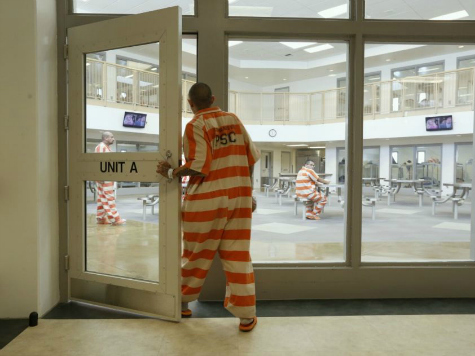
Governor Jerry Brown’s ongoing “realignment” response to court orders requiring a reduction in California’s prison crowding is sending all but the worst criminals flooding back to county jails for a brief visit and then back on the streets. A Los Angeles Times investigative report revealed the newly over-crowded county jails are also refusing to “book” into jail many serious criminal offenders. Those that do get jailed are bouncing back out on the streets after serving less than 10% of their sentences.
The Times analysis demonstrated that “incarceration in some counties has been curtailed or virtually eliminated for a variety of misdemeanors, including parole violations, domestic violence, child abuse, drug use and driving under the influence.” In Los Angeles County, where one in four Californian jail inmates reside, only 10% of time served for male inmates and 5% for female inmates “often” qualified for release “back in the community.”
Most parole violators, rather than being sent back to prison, are now winding up in county jails. The rising flood of probationer “round-trips” for crimes has forced Los Angeles County to hire 500 additional staffers; Riverside County has added 140 new staffers.
The Times referred to the metastasizing problem as creating a “revolving door” for dangerous criminals at jailhouses. Hardened inmates are being booted out of jail only to return on new charges. Parolee supervision has been often been reduced to interacting with user-friendly automated kiosks.
The Times reports that in 2011, California averaged 9,700 released inmates per month. Today that number has leaped to an average of 13,500 a month. The system set an all-time record when 17,400 bounced out on the streets in October 2013.
A PublicCEO article revealed “it’s an open secret” that state legislators and local officials knew about realignment’s negative consequences on prisons and county jails. Under the “Golden Dome” in Sacramento, the legislature “realigned” the budget by sending $850 million to counties last fiscal year and $1 billion this year to handle dumping prisoners, according to state corrections department spokesman Luis Patino.
Although the realignment has reduced the state prison population, it has created a new entitlement for counties to construct more jail cells. Stanislaus County received $80 million for jail expansion as the first tranche of a $1.2 billion allocation under Assembly Bill 900, the Public Safety and Offender Rehabilitation Services Act of 2007.
The Times article worries that even left-leaning criminal justice critics are now objecting to the heavy costs associated with realignment. Vonya Quarles, an organizer with the All of Us or None organization, told the Modesto Bee that the Stanislaus project “is good for jobs and the builders, but the outcome of jail expansion has been nothing but failure,” underscoring the “over $50,000 cost to keep an inmate in county jail for a year.”
The left is trying to tout that realignment from 2006-2012 has cut violent crime by 21% as the prison population fell by 23%, according to a study by the Sentencing Project. But opponents say such statistics are bogus because the six-year study “did not include the current spike in violent offenders released early,” and many criminals are “allowed to plead down” normally criminal offenses to misdemeanors since jails are full.
A major reason that crime rates fell during the period of the study is that police officer staffing increased nationally by 20% between 1995 and 2010. Policing has especially improved in Los Angeles with officers using “CompStat” data to target resources and civil engagement with the public in “Hotspots.”
But now that realignment has made “catch and release” the norm for policing in most California counties, criminals will seldom be discouraged about “spending time in the can” for committing most crimes.
The author will respond to readers’ comments.

COMMENTS
Please let us know if you're having issues with commenting.